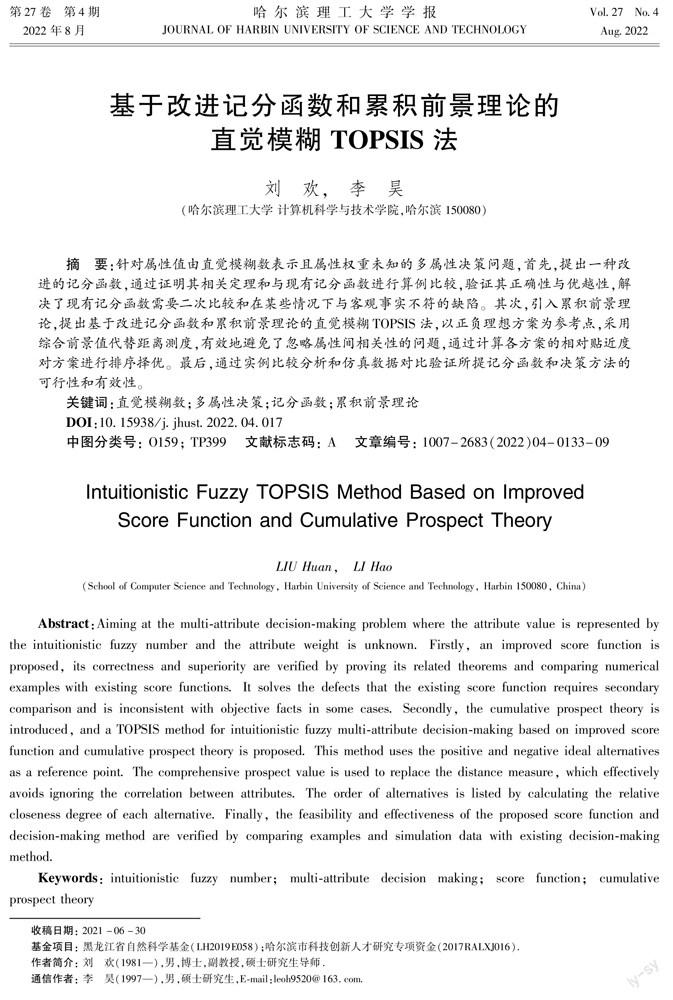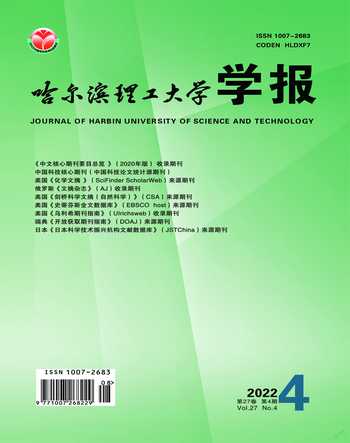基于改进记分函数和累积前景理论的直觉模糊TOPSIS法
刘欢 李昊



摘要:针对属性值由直觉模糊数表示且属性权重未知的多属性决策问题,首先,提出一种改进的记分函数,通过证明其相关定理和与现有记分函数进行算例比较,验证其正确性与优越性,解决了现有记分函数需要二次比较和在某些情况下与客观事实不符的缺陷。其次,引入累积前景理论,提出基于改进记分函数和累积前景理论的直觉模糊TOPSIS法,以正负理想方案为参考点,采用综合前景值代替距离测度,有效地避免了忽略属性间相关性的问题,通过计算各方案的相对贴近度对方案进行排序择优。最后,通过实例比较分析和仿真数据对比验证所提记分函数和决策方法的可行性和有效性。
关键词:直觉模糊数;多属性决策;记分函数;累积前景理论
DOI:10.15938/j.jhust.2022.04.017
中图分类号: O159; TP399
文献标志码: A
文章编号: 1007-2683(2022)04-0133-09
Intuitionistic Fuzzy TOPSIS Method Based on Improved
Score Function and Cumulative Prospect Theory
LIU Huan,LI Hao
(School of Computer Science and Technology, Harbin University of Science and Technology, Harbin 150080, China)
Abstract:Aiming at the multi-attribute decision-making problem where the attribute value is represented by the intuitionistic fuzzy number and the attribute weight is unknown. Firstly, an improved score function is proposed, its correctness and superiority are verified by proving its related theorems and comparing numerical examples with existing score functions. It solves the defects that the existing score function requires secondary comparison and is inconsistent with objective facts in some cases. Secondly, the cumulative prospect theory is introduced, and a TOPSIS method for intuitionistic fuzzy multi-attribute decision-making based on improved score function and cumulative prospect theory is proposed. This method uses the positive and negative ideal alternatives as a reference point. The comprehensive prospect value is used to replace the distance measure, which effectively avoids ignoring the correlation between attributes. The order of alternatives is listed by calculating the relative closeness degree of each alternative. Finally, the feasibility and effectiveness of the proposed score function and decision-making method are verified by comparing examples and simulation data with existing decision-making method.
Keywords:intuitionistic fuzzy number; multi-attribute decision making; score function; cumulative prospect theory
0引言
多属性决策广泛应用于社会治理、产业经济、企业管理等多个领域,如风险评估[1]、供应商选择[2]等。Atanassov[3]在1986年将非隶属度引入模糊集,提出了直觉模糊集的概念,自此,对于直觉模糊多属性决策的研究日益深入[4-5。为了方便直觉模糊数的计算和比较,学者们提出了以记分函数将直觉模糊数转化成实数,其中Chen等[6]在1994年最先定义了记分函数的概念来处理直觉模糊数。后来,经过不断研究和发展,许多学者对记分函数加以改进,例如文[7]针对Chen等[5]提出的记分函数的缺陷,提出了精确函数的概念,文[8-12]综合考虑直觉模糊数的隶属度、非隶属度和犹豫度的影响,提出新的记分函数来比较直觉模糊数的大小。然而,目前的记分函数仍然存在一定的缺陷,比如文[6,9-10]中提出的记分函数在两个直觉模糊数各自的隶属度与非隶属度相等情况下无法直接判断两个直觉模糊数的大小,还需要借助辅助函数对直觉模糊数进行二次比较;文[11-12]中提出的記分函数无法满足人们通常更愿意选择没有人反对的结果这一客观事实,文[9]无法满足一般情况下人们普遍认为精确度和隶属度越高,该直觉模糊数越优的认知习惯。因此,记分函数的精确性和合理性仍然有待提升。
1992年,Kahneman和Tversky提出了累積前景理论[13]。累积前景理论相对于前景理论很好地解释了随机占优等现象,因而被广泛应用。TOPSIS法基本原理是通过计算备选方案与正负理想方案的距离来进行优劣排序,最优方案的选取应该是最贴近正理想方案同时离负理想方案又最远,否则不为最佳[14-15]。由于TOPSIS 法中认为决策者是完全理性的,因此,学者们结合前景理论的特征,逐渐将前景理论引入到 TOPSIS 法中。比如,王娟等[16]将前景理论引入到三角犹豫模糊环境下的 TOPSIS 法中,陈六新等[17]将前景理论引入到勾股模糊环境下的TOPSIS法中,以反映决策者心理行为特征对决策的影响。
本文针对属性值由直觉模糊数表示且属性权重未知的多属性决策问题,提出一种基于改进记分函数和累积前景理论的直觉模糊TOPSIS 法。首先,该方法针对现有记分函数存在的一些缺陷提出一种改进的记分函数;接着,综合考虑主客观因素,以属性值总差异最大化且属性权重差异最小化为目标建立优化模型来确定属性权重,即一方面为维护属性权重的公平性,应使属性权重的差异最小,另一方面为有利于方案的排序,应使属性值的总差异最大;然后,引入累积前景理论,将正负理想方案作为参考点,计算各方案相对于参考点的损失值和收益值,并构建前景损失值矩阵和前景收益值矩阵;最后,计算各备选方案的综合前景损失值和综合前景收益值,进而计算各方案的相对贴近度,按相对贴近度以从大到小的顺序对方案进行排序择优。本文通过实例比较和生成50组仿真数据来验证该方法的可行性和有效性。
1预备知识
1.1直觉模糊集
1.2累积前景理论
2记分函数的提出
2.1现有记分函数分析
2.2改进的记分函数
2.3不同记分函数之间的比较分析
3基于改进记分函数和累积前景理论的直觉模糊TOPSIS 法
3.1问题描述
3.2属性权重的确定
3.3方法步骤
4实例研究与比较分析
4.1实例研究
4.2比较分析
5结论
本文针对现有记分函数存在的一些缺陷,提出了一种改进的记分函数,改进的记分函数克服了已知记分函数存在的某些缺陷,即可以通过改进的记分函数来比较两个各自的隶属度与非隶属度相等的直觉模糊数的大小,以及满足人们更愿意选择没有人反对的结果这一客观事实,还满足人们普遍认为精确度和支持度越高的直觉模糊数越优的认知习惯。针对属性值为直觉模糊数的多属性决策问题,提出了一种基于改进记分函数和累积前景理论的直觉模糊TOPSIS 法,该方法采用综合前景损失值和综合前景收益值代替各方案与正负理想方案之间的距离测度,有效地避免了忽略属性间相关性的问题,另外还将该方法应用于实例与已知决策方法进行比较分析,并进行多组仿真数据对比,证明了该方法的可行性和有效性。
参 考 文 献:
[1]王博, 王建玲. 企业财务管理风险的模糊多属性评价法[J]. 统计与决策, 2019, 35(1): 186.WANG Bo, WANG Jianling. Fuzzy Multi-attribute Evaluation Method of Enterprise Financial Management Risk [J]. Statistics & Decision, 2019, 35(1): 186.
[2]王世磊, 屈绍建, 马刚. 基于前景理论和模糊理论的在线多属性采购拍卖供应商选择决策[J]. 控制与决策, 2020, 35(11): 2637.WANG Shilei, QU Shaojian, MA Gang. Decision Method of Supplier Selection for Online Multi-attribute Procurement Auction Based on Prospect Theory and Fuzzy Theory [J]. Control and Decision, 2020, 35(11): 2637.
[3]ATANASSOV K. Intuitionistic Fuzzy Sets[J]. Fuzzy Sets & Systems, 1986, 20(1): 87.
[4]ZHANG Shuang, WANG Nianbin, LIU Huan, Approaches to Multiple Attribute Decision Making with the Intuitionistic Fuzzy Information and Their Applications to User Activities Reliability Evaluation[J]. Proceedings of the National Academy of Sciences, India Section A: Physical Sciences, 2018, 88(1): 90.
[5]WANG L. A Multi-criteria Group Decision Making Method and Its Applications Based on Improved Intuitionistic Fuzzy Entropy and Information Integration Operator[J]. International Journal of Information and Management Sciences, 2020, 31(4): 386.
[6]CHEN S M, TAN J M. Handing Multi-criteria Fuzzy Decision-making Problems Based on Vague Set Theory[J]. Fuzzy Sets & Systems, 1994, 67(2): 164.
[7]HONG D H, CHOI C H. Multi-criteria Fuzzy Decision-making Problems Based on Vague Set Theory[J]. Fuzzy Sets and Systems, 2000, 114(1): 105.
[8]YE J. Improved Method of Multi- criteria Fuzzy Decision-making Based on Vague Sets[J]. Computer-Aided Design, 2007, 39(2): 165.
[9]王坚强, 李婧婧. 基于记分函数的直觉随机多准则决策方法[J]. 控制与决策, 2010, 25(9): 1299.WANG Jianqiang, LI Jingjing. Intuitionistic Random Multi-criteria Decision-making Approach Based on Score Functions[J]. Control and Decision, 2010, 25(9): 1299.
[10]李鹏, 刘思峰, 朱建军. 基于前景理论的随机直觉模糊决策方法[J]. 控制与决策, 2012, 27(11): 1603.LI Peng, LIU Sifeng, ZHU Jianjun. Intuitionistic Fuzzy Stochastic Multi-criteria Decision-making Methods Based on Prospect theory[J]. Control and Decision, 2012, 27(11): 1603.
[11]NAYAGAM VLG, JEEVARAI S, SIVARAMAN G. Total Ordering Defined on the Set of All Intuitionistic Fuzzy Numbers[J]. Journal of Intelligent and Fuzzy Systems, 2016, 30(4): 3.
[12]高建偉, 郭奉佳. 基于改进前景理论的直觉模糊随机多准则决策方法[J].控制与决策, 2019,34(2):317.GAO Jianwei, GUO Fengjia. Intuitionistic Fuzzy Stochastic Multi-criteria Decision-making Method Based on Modified Prospect Theory[J]. Control and Decision, 2019, 34(2): 320.
[13]TVERSKYD, KAHNEMAN A. Advances in Prospect Theory: Cumulative Representation of Uncertainty[J]. Journal of Risk and Uncertainty, 1992, 5(4): 297.
[14]陈志霞, 徐杰. 基于TOPSIS与灰色关联分析的城市幸福指数评价[J]. 统计与决策, 2021, 37(9): 59.CHEN Zhixia, XU Jie. Urban Happiness Index Evaluation Based on TOPSIS and Grey Correlation Analysis[J]. Statistics & Decision, 2021, 37(9):59.
[15]SHA X Y, YIN C C, XU Z S, et al. Probabilistic Hesitant Fuzzy TOPSIS Emergency Decision-making Method Based on the Cumulative Prospect Theory[J]. Journal of Intelligent & Fuzzy Systems, 2021, 40(3): 4367.
[16]王娟, 金智新, 邓存宝, 等. 基于前景理论的三角犹豫模糊多属性决策方法[J]. 运筹与管理, 2019, 28(7): 26.WANG Juan, JIN Zhixin, DENG Cunbao, et al. Multiple Attribute Decision Making Method for Hesitant Triangular Fuzzy Based on Prospect Theory[J]. Operations Research and Management Science, 2019, 28(7): 26.
[17]陈六新, 罗南方. 基于前景理论的勾股模糊多属性决策[J]. 系统工程理论与实践, 2020, 40(3): 726.CHEN Liuxin, LUO Nanfang. Pythagorean Fuzzy Multi-criteria Decision-making Based on Prospect Theory[J]. Systems Engineering-Theory & Practice, 2020, 40(3): 726.
[18]MUHAM T, KIRAN S, RIDA I, et al. Evaluation Model for Manufacturing Plants with Linguistic Information in Terms of Three Trapezoidal Fuzzy Numbers[J]. Journal of Intelligent & Fuzzy Systems, 2020, 38(5): 5970.
[19]WANG J, WEI G W, WEI C,et al. Maximizing Deviation Method for Multiple Attribute Decision Making Under Q-rung Orthopair Fuzzy Environment[J]. Defence Technology, 2020, 16(5): 1075.
[20]HADI-VENCHEH A, MIRJABERI M. Fuzzy Inferior Ratio Method for Multiple Attribute Decision Making Problems[J]. Information Sciences, 2014, 277: 265.
(编辑:温泽宇)

